The graphic nature of the symmetric group
Abstract.
We investigate a remarkable class of exponential sums which are derived from the symmetric groups and which display a diverse array of visually appealing features. Our interest in these expressions stems not only from their astounding visual properties, but also from the fact that they represent a novel and intriguing class of supercharacters.
1. Introduction
Our aim in this note is to study a remarkable class of exponential sums which are derived from the symmetric groups and which display a diverse array of visually appealing features. To be more specific, we are concerned here with the properties of certain complex-valued functions associated to orbits in arising from the natural permutation action of the symmetric group . The images of these functions, when plotted as subsets of the complex plane, display a wide variety of striking features of great complexity and subtlety (see Figures 1 and 2).
Our interest in these functions stems not only from their astounding visual properties, but also from the fact that they represent a novel and intriguing class of supercharacters. The theory of supercharacters, of which classical character theory is a special case, was recently introduced in an axiomatic fashion by P. Diaconis and I.M. Isaacs in 2008 [6], who generalized earlier work of C. André [1, 2, 3]. More recently, the study of supercharacters on abelian groups has proven surprisingly fruitful [4, 10, 5, 9, 7]. It is in this novel framework that our exponential sums arise.
We make no attempt to survey the rapidly evolving literature on supercharacters and focus only on the essentials necessary for our investigations. To get started, we require the following important definition.
Definition (Diaconis-Isaacs [6]).
Let be a finite group, let be a partition of the set of irreducible characters of , and let be a partition of . We call the ordered pair a supercharacter theory if
-
(i)
contains , where denotes the identity element of ,
-
(ii)
,
-
(iii)
For each in , the character is constant on each in .
The characters are called supercharacters and the elements of are called superclasses.
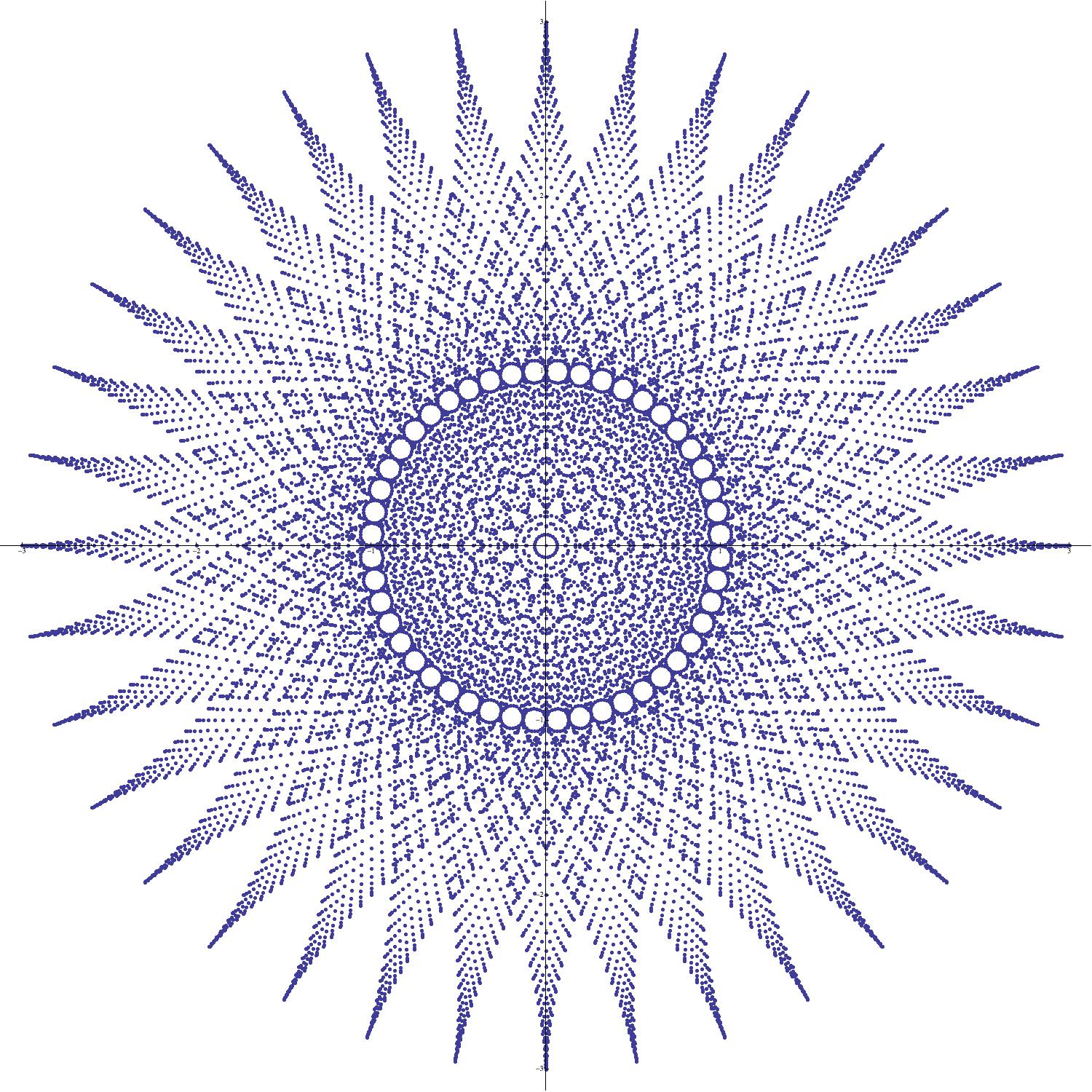
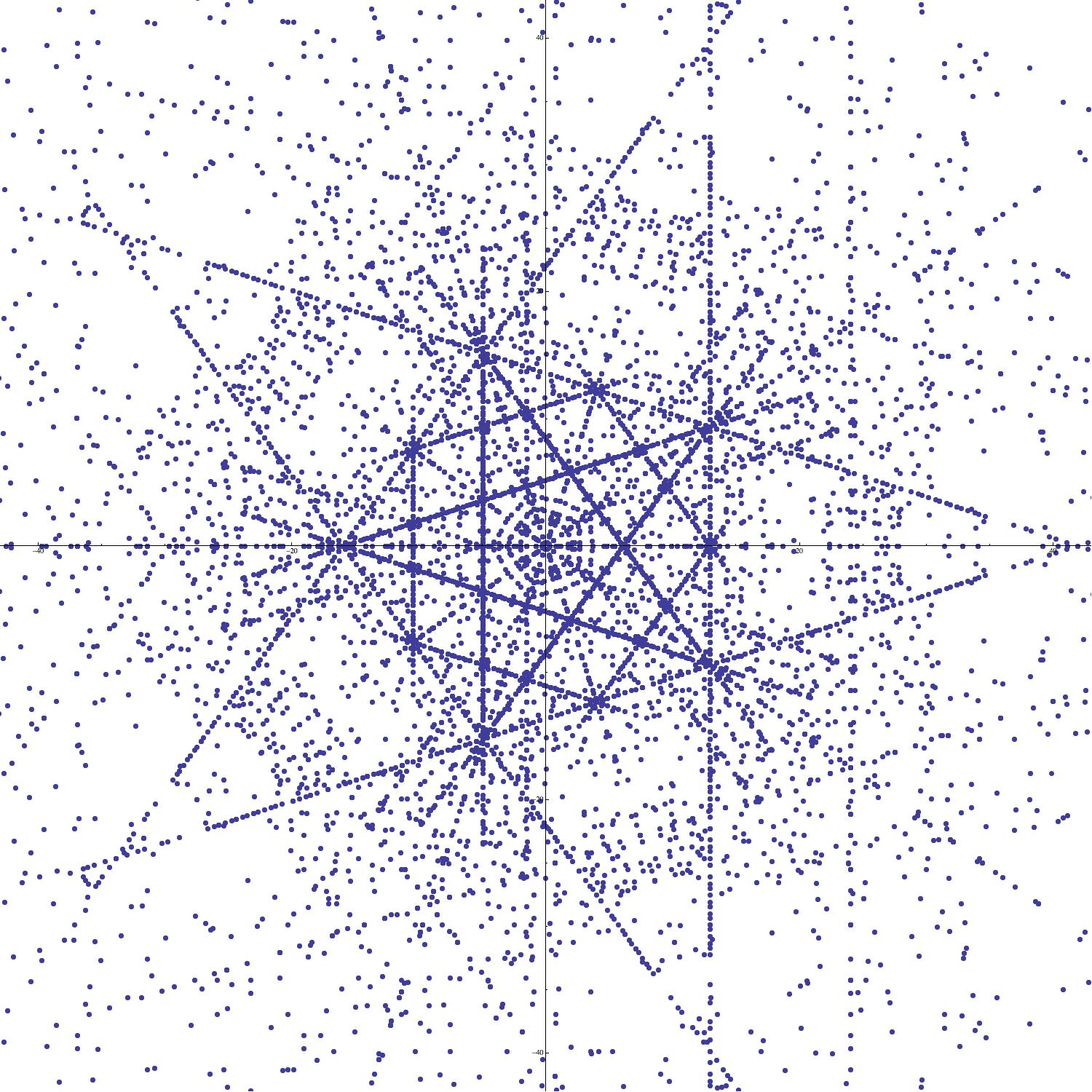

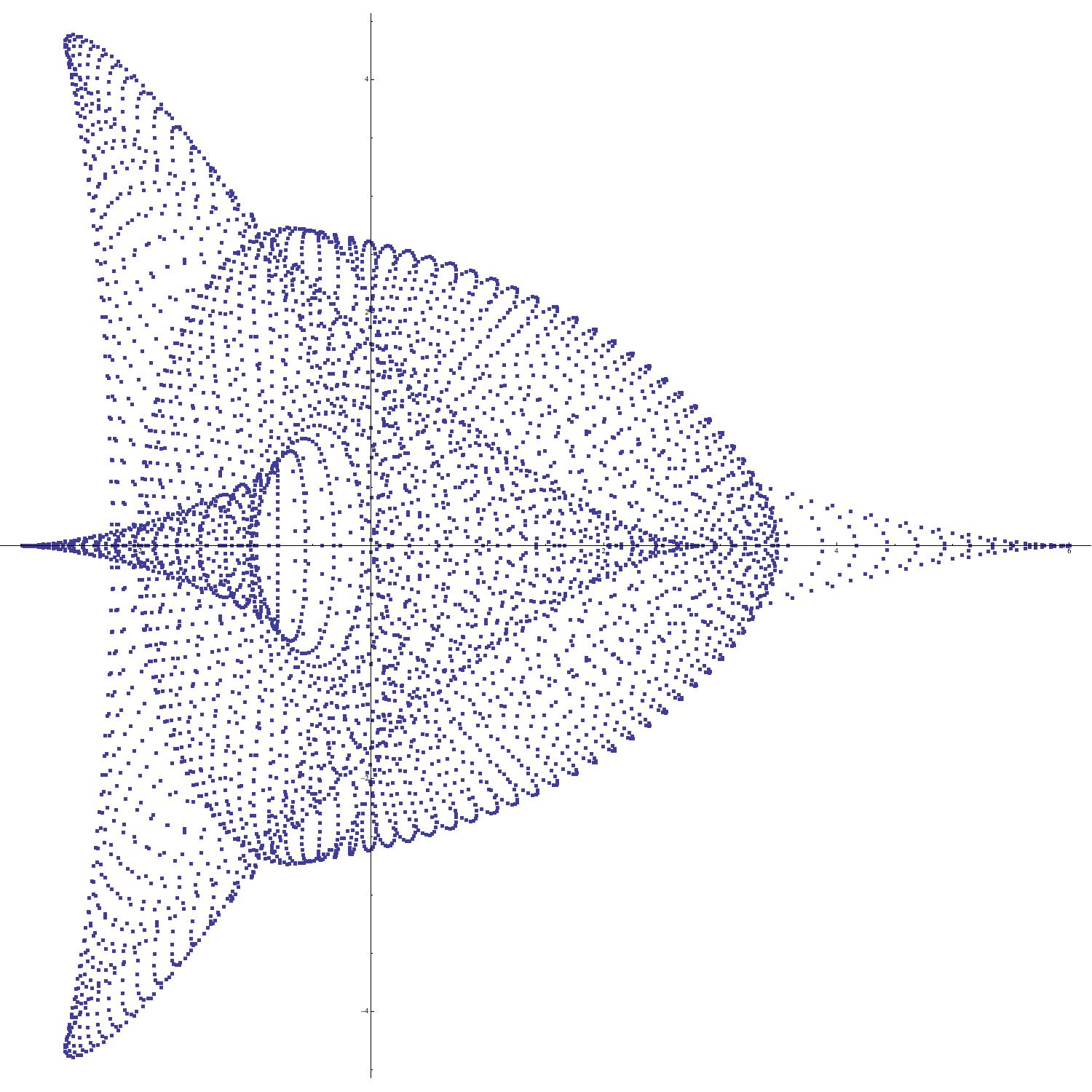
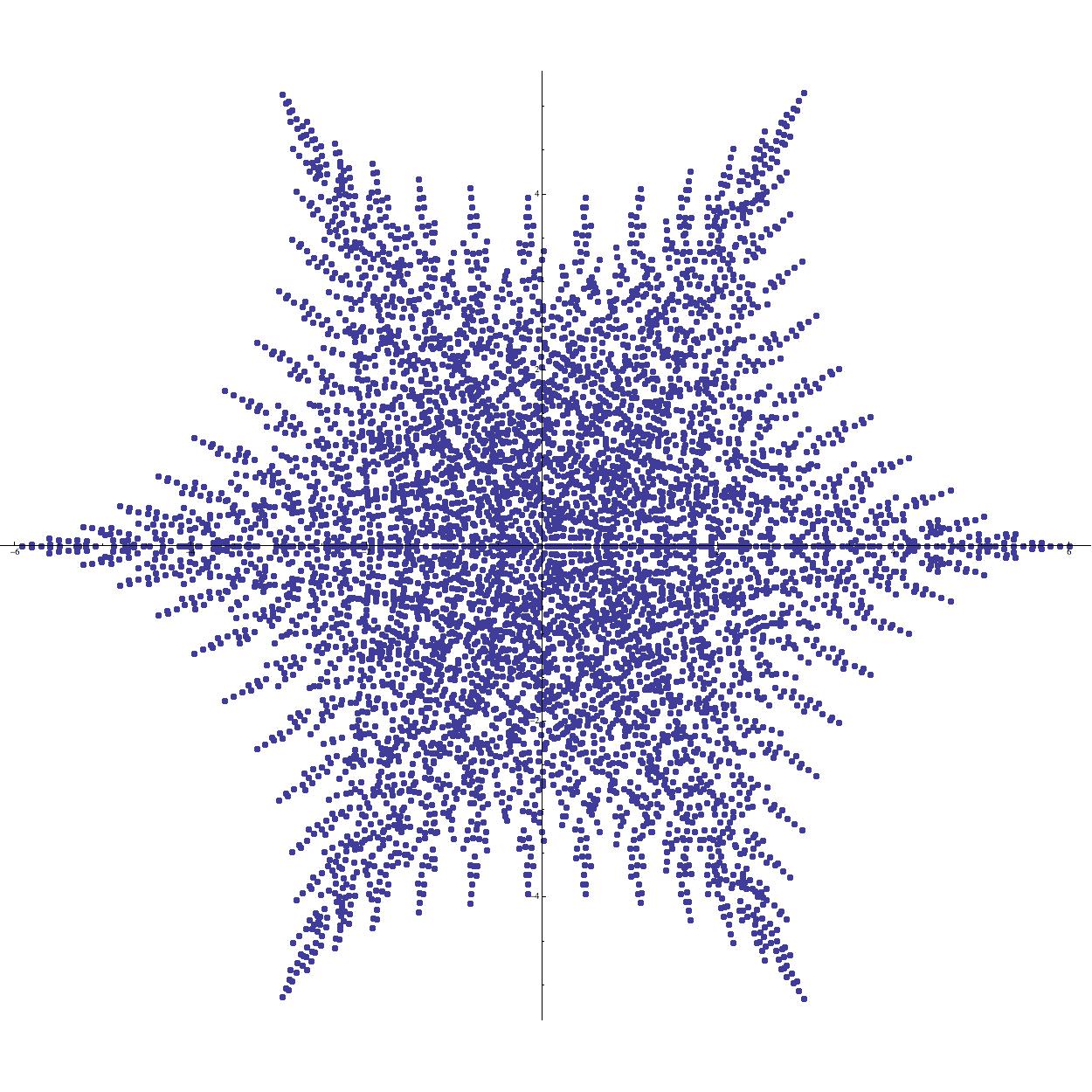
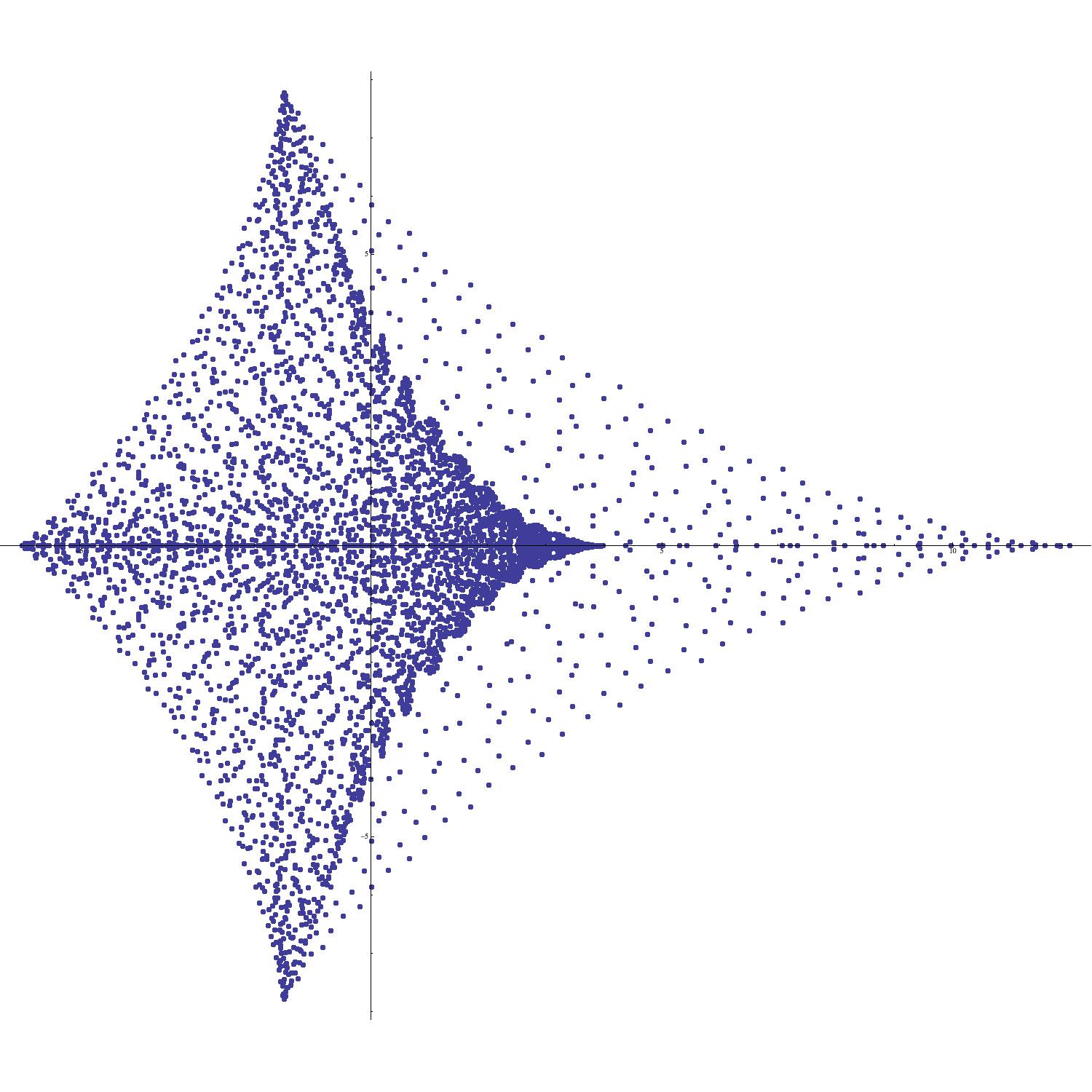
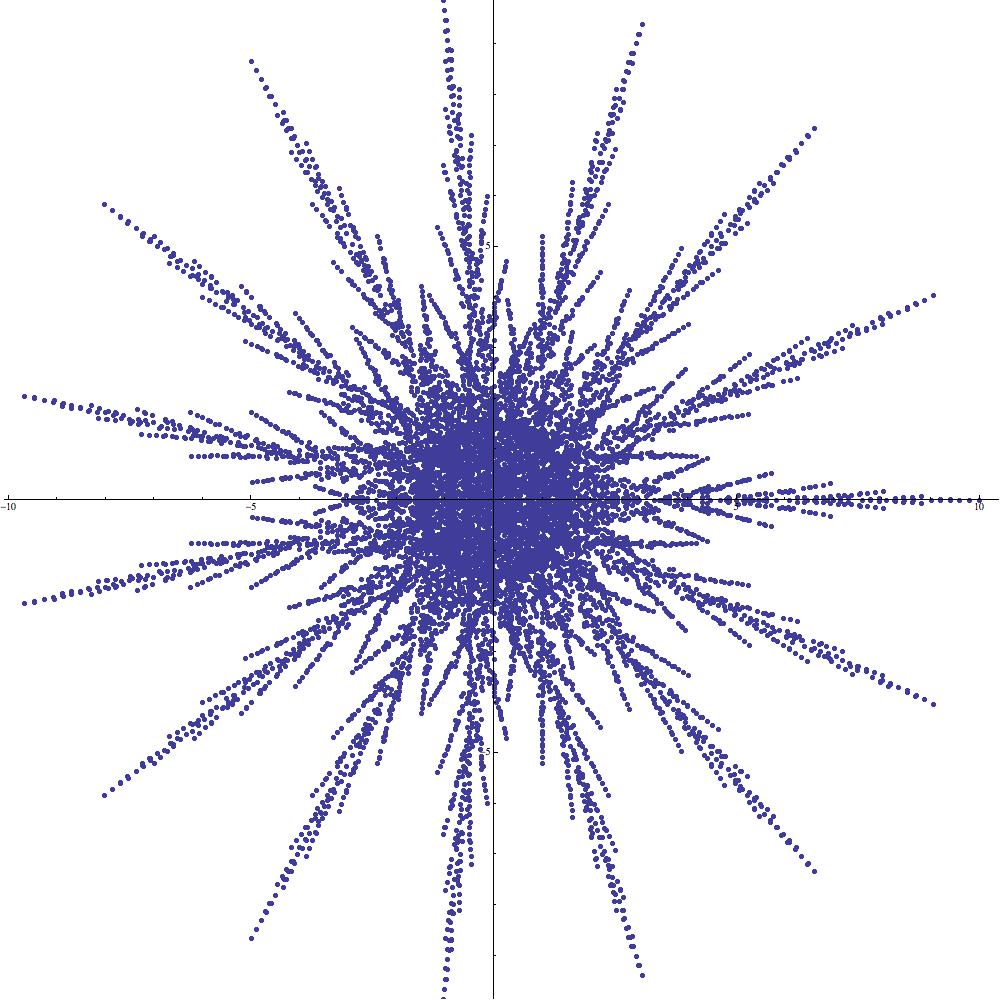

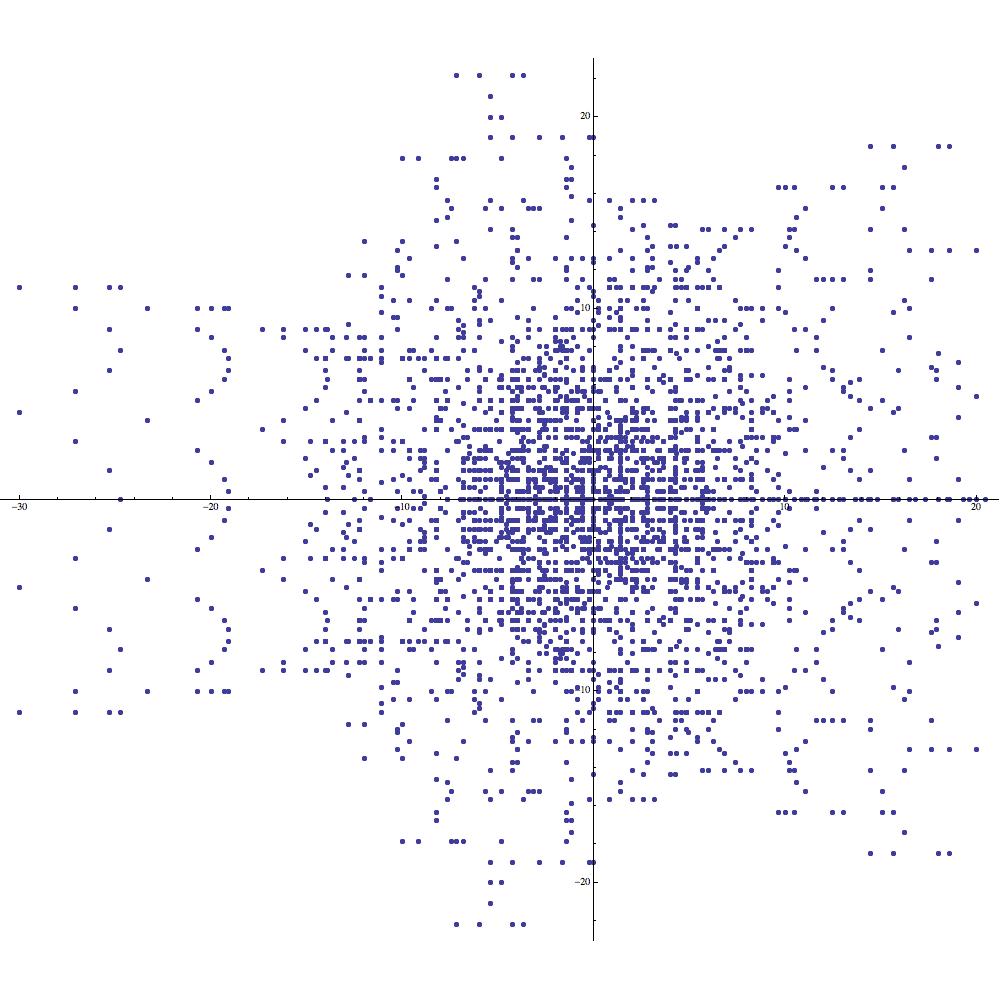
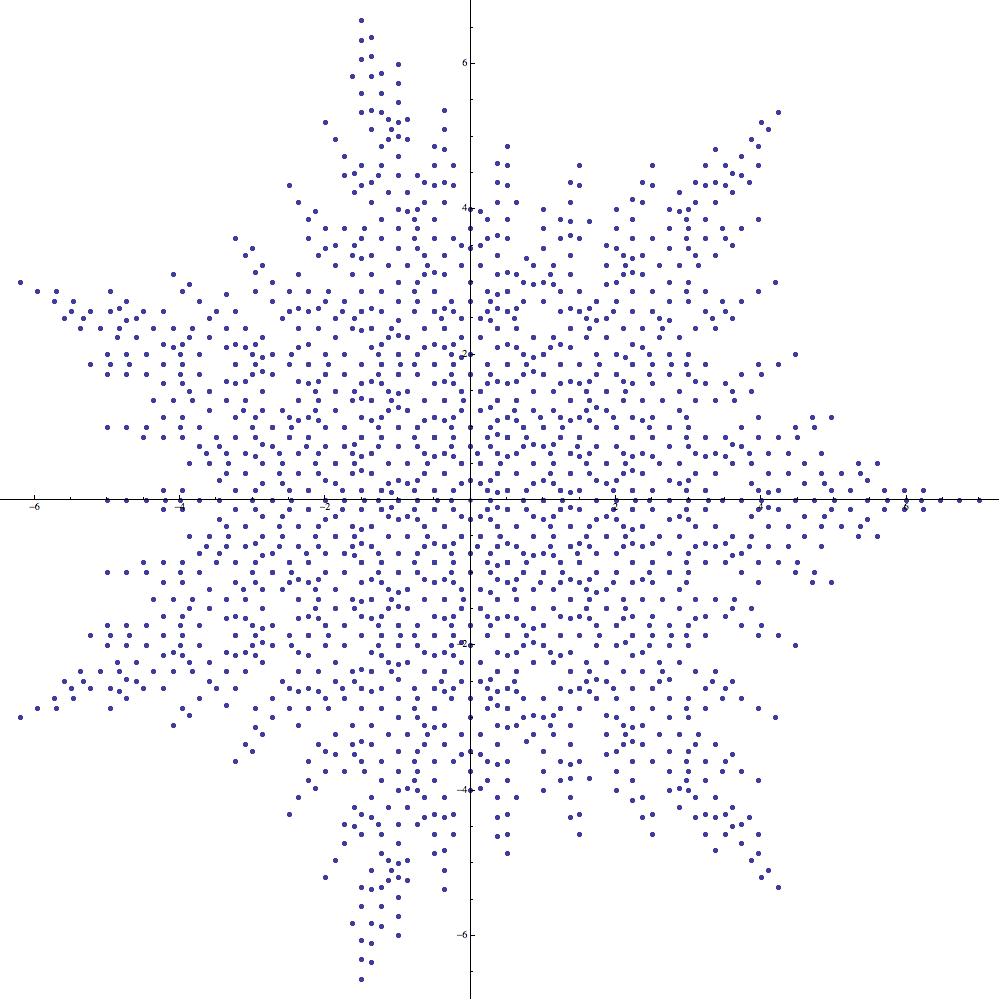

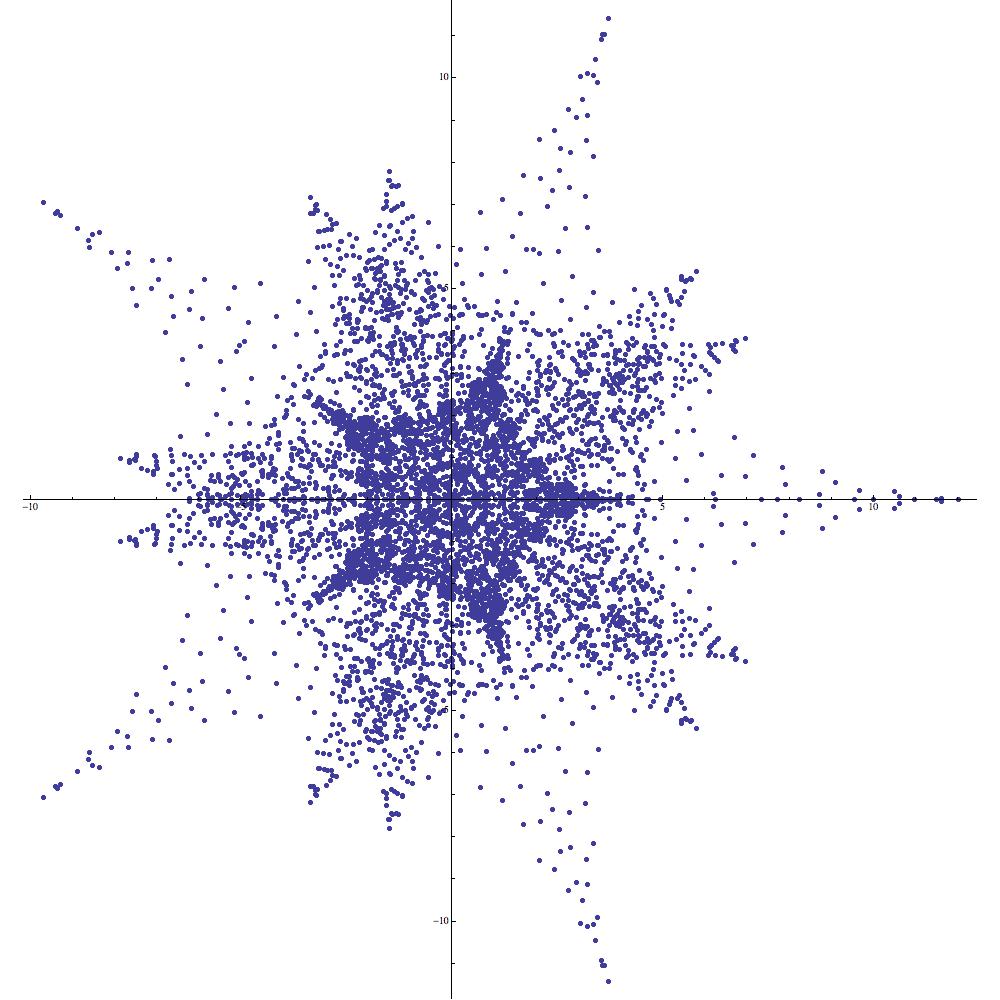
It turns out that a variety of exponential sums which are of interest in number theory can be viewed quite profitably as supercharacters on certain abelian groups [9, 5, 7]. Although the sums we propose to study do not appear to have such celebrated names attached to them, they are produced by the same mechanism as the expressions displayed in Table 1.
One way to construct a supercharacter theory on a given finite group is to employ the action of a subgroup of to obtain the partition . In this setting, the elements of are precisely the orbits in under the action of . One then seeks a compatible action of on and appeals to a result of Brauer [11, Thm. 6.32, Cor. 6.33] to conclude that the actions of on and on yield the same number of orbits. The precise details of the general case do not concern us here, for the groups and automorphisms we consider below will be completely transparent.
In the following, we denote by and typical elements of and let . We also set , so that the function is periodic with period . We are interested here in the supercharacter theory on induced by the natural permutation action of the symmetric group . In this setting, the superclasses are simply the orbits in . Recalling that , where , we let act upon in the obvious manner by setting . Letting denote the set of orbits in and denote the set of orbits in , it is clear that . We often denote this common value by .
Although the elements of each orbit in are certain characters , we identify with the vector so that is stable under the action of . Having established this convention, for each in we define the corresponding character
| (1.1) |
noting that whenever and belong to the same orbit.111If , then , where denotes the permanent of a matrix. The pair constructed above is a supercharacter theory on .222One can also view this endeavor in terms of the classical character theory of the semidirect product (sometimes referred to as a generalized symmetric group). However, the supercharacter approach cleaner and more natural since is highly nonabelian and possesses a large number of conjugacy classes, whereas is abelian and, by comparison, has relatively few superclasses. Moreover, many of the irreducible characters of are uninteresting for our purposes (e.g., assuming only or th roots of unity as values).
We refer to the characters (1.1) as symmetric supercharacters (or often just supercharacters) and the sets as superclasses. Expanding upon the notational liberties we have taken above, we choose to identify , whose elements are the irreducible characters which comprise , with the set of vectors . Having made this identification, we see that . In light of this, we frequently regard the elements of as superclasses. Since is constant on each superclass , if belongs to we often write instead of .
In addition to (1.1), there is another description of symmetric supercharacters which is more convenient in certain circumstances. Letting , it follows that the orbit contains copies of whence
| (1.2) |
Although we do not need the following observation for our work, it is worth mentioning since it indicates that symmetric supercharacters also enjoy a variety of nontrivial algebraic properties. Fixing an enumeration of , we label the supercharacters corresponding to these sets . It is possible to show that the matrix
| (1.3) |
is symmetric (i.e., ) and unitary. In fact, encodes a type of Fourier transform on the space of superclass functions (i.e., functions which are constant on each superclass). This is a consequence of more general considerations, of which symmetric supercharacters are a special case. Complete details can be found in [5], although some of these ideas are already present in [9, 8].
We are now ready to proceed to the heart of the paper (Section 2), where a variety of features of symmetric supercharacters are surveyed, documented, and explored. As one might expect from a paper appearing in this particular venue, most of the phenomena described below were discovered experimentally. While we are able to explain some of these phenomena, many others remain largely mysterious. In light of this, we conclude with a number of open problems motivated by our numerical investigations (Section 3). We invite other mathematicians, perhaps those armed with more sophisticated tools than we here possess, to continue our work, for the study of symmetric supercharacters is surely fertile ground. To this end, we include in Appendix A the Mathematica code used to produce our supercharacter plots.
2. Graphical properties
Our approach here will be to survey and explain a variety of intriguing qualitative features exhibited by the images of symmetric supercharacters. We proceed roughly in order of increasing complexity, starting here with the most elementary properties.
2.1. Maximum modulus
Since there are precisely terms of unit modulus which comprise the sum which defines , it follows that for all in . Setting reveals that this inequality is sharp. If where the vector in has precisely occurrences of the elements (so that ), then it follows that
2.2. Conjugate symmetry
For each superclass , the set obtained by negating each element of is another superclass. The definition (1.1) now yields
| (2.1) |
Thus the image of any is symmetric with respect to the real axis (see Figure 3). Furthermore, if , then is real-valued (see Figure 4).





2.3. Dihedral Symmetry
Let us introduce several notational conventions which will prove useful in what follows. For each in , we let
observing that for all in . For each superclass we may define unambiguously by setting it equal to for any representative of . We also let so that is superclass whenever is.
We say that a subset of the complex plane has -fold dihedral symmetry if it is invariant under the action of the dihedral group of order . To establish that a given supercharacter plot enjoys -fold dihedral symmetry it suffices to show that it is invariant under rotation through an angle of . The degree of symmetry enjoyed by a supercharacter plot is governed by the quantity (see Figure 5).
Proposition 1.
The image of a symmetric supercharacter has -fold dihedral symmetry.
Proof.
First observe that
Since the congruence is solvable if and only if divides , it follows that the image of has -fold dihedral symmetry. ∎






Although individual supercharacter plots may have only symmetry (e.g., Figure 4), when one considers the images of all symmetric supercharacters on simultaneously, one obtains a much higher degree of symmetry (see Figure 6).
Proposition 2.
For fixed, the union
of all symmetric supercharacter plots on has -fold dihedral symmetry.
Proof.
Fixing and , we first note that
| (2.2) |
We therefore wish to identify the smallest positive for which the congruence
| (2.3) |
can be solved for and given any prescribed values of and . Setting reveals that . In fact, we wish to show that (2.3) can always be solved when .
By the Chinese Remainder Theorem, it suffices to show that
| (2.4) |
can be solved for each prime power which appears in the canonical factorization of . There are three special cases which are easy to dispatch:
-
•
If , then let and .
-
•
If , then let and .
-
•
If , then let and .
We may therefore assume that , , and , where and . This leads to two special cases:
- •
-
•
If , then let and observe that . It follows from (2.4) that
(2.5) By our choice of , at least one of , , and must equal . In other words, at least one of the coefficients in (2.5) is relatively prime to the modulus of the congruence. In light of the three special cases considered above, we conclude that (2.5), and hence (2.4), is solvable.
Putting this all together, we see that when , the congruence (2.3) can be solved for and , given any fixed values of and . This concludes the proof. ∎



2.4. Restricted walks
The simplest nontrivial symmetric supercharacters for which a nice qualitative description exists are those of the form where . Writing , we find that
| (2.6) |
so that the values attained by coincide with the endpoints of all -step walks starting at the origin and having steps of unit length which are restricted to the directions for .
The “boundary” of the image is easy to describe. The furthest from the origin one can get in steps are the points , which correspond to taking all steps in the same direction. Also accessible to our walker are the points for which lie along the sides of the regular -gon determined by the vertices . There is also an iterative interpretation of (2.6), for we can also think of our -step walk as being the composition of a -step walk followed by a -step walk (see Figure 7).




A similar treatment exists for the supercharacters . If , then a glance at (2.6) indicates that the image is identical to the image corresponding to . On the other hand, if where , then the image obtained is identical to the image of the supercharacter . This corresponds to a -step walk with directions restricted to directions (see Figure 8).






2.5. Spikes
Under certain circumstances, the image of a symmetric supercharacter is contained in the union of a relatively small number of evenly spaced rays emanating from the origin. The following proposition provides a simple condition which ensures such an outcome (see Figure 9).
Proposition 3.
If for some in , then the image of is contained in the union of the rays given by for .
Proof.
Since , for each in there exists a permutation such that . Using (1.2) we find that
where is an integer which depends on . It follows from the preceding that
from which the desired result follows. ∎


Example 1.
With more information, we can sometimes improve substantially upon Proposition 3. Consider the supercharacter corresponding to
Since , it follows from Proposition 3 that the image of is contained in the union of equally spaced rays emanating from the origin. However, we can be much more specific. Letting , we see that
| (2.7) |
Noting that the second term in (2.7) lies in the interval , we can see that the qualitative behavior of depends heavily upon the parity of (see Figure 10).
-
•
If is odd, then the image of is contained in the union of rays, of which have length while the remaining rays have length approximately (see Figure 10(a)).
-
•
If is even, then the image of is contained in the union of rays, each of length (see Figure 10(b)). Due to “double coverage,” the concentration of points is higher in the region .


2.6. Hypocycloids
Hypocycloids are suggested in many symmetric supercharacter plots and they form the basis of more complicated constructions. Recall that a hypocycloid is a planar curve obtained by tracing the path of a fixed point on a small circle which rolls inside a larger circle. The parametric equations
| (2.8) |
describe the -cusped hypocycloid obtained by rolling a circle of radius inside of a circle of integral radius centered at the origin.
Proposition 4.
If , then the image of is bounded by the hypocycloid determined by (2.8).
Proof.
Noting that are completely determined by the values of the arbitrary parameters and in , it follows that runs over all values in when and over the set of all -tuples of the form otherwise. Thus the image of closely approximates the filled hypocycloid when is large (see Figure 11).

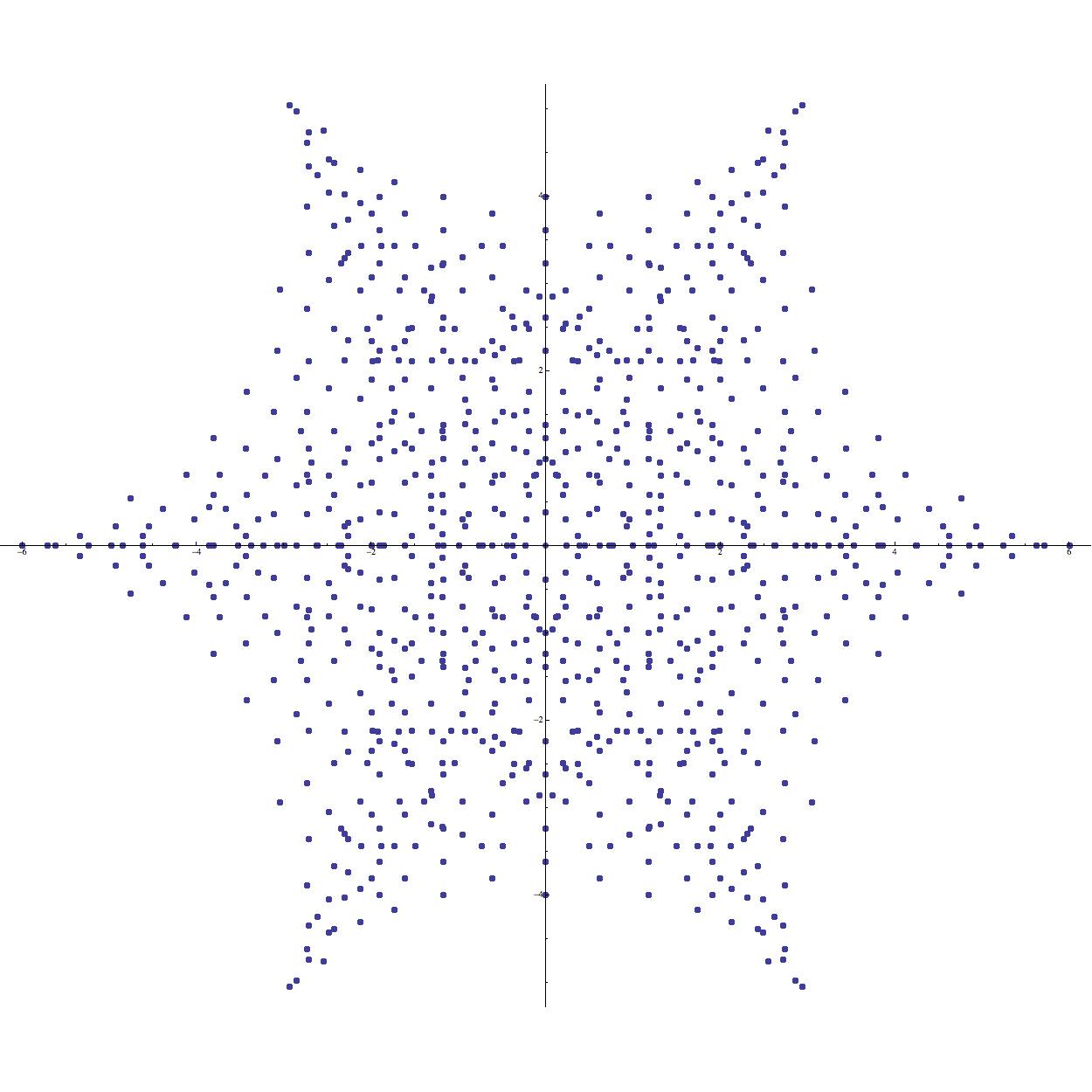
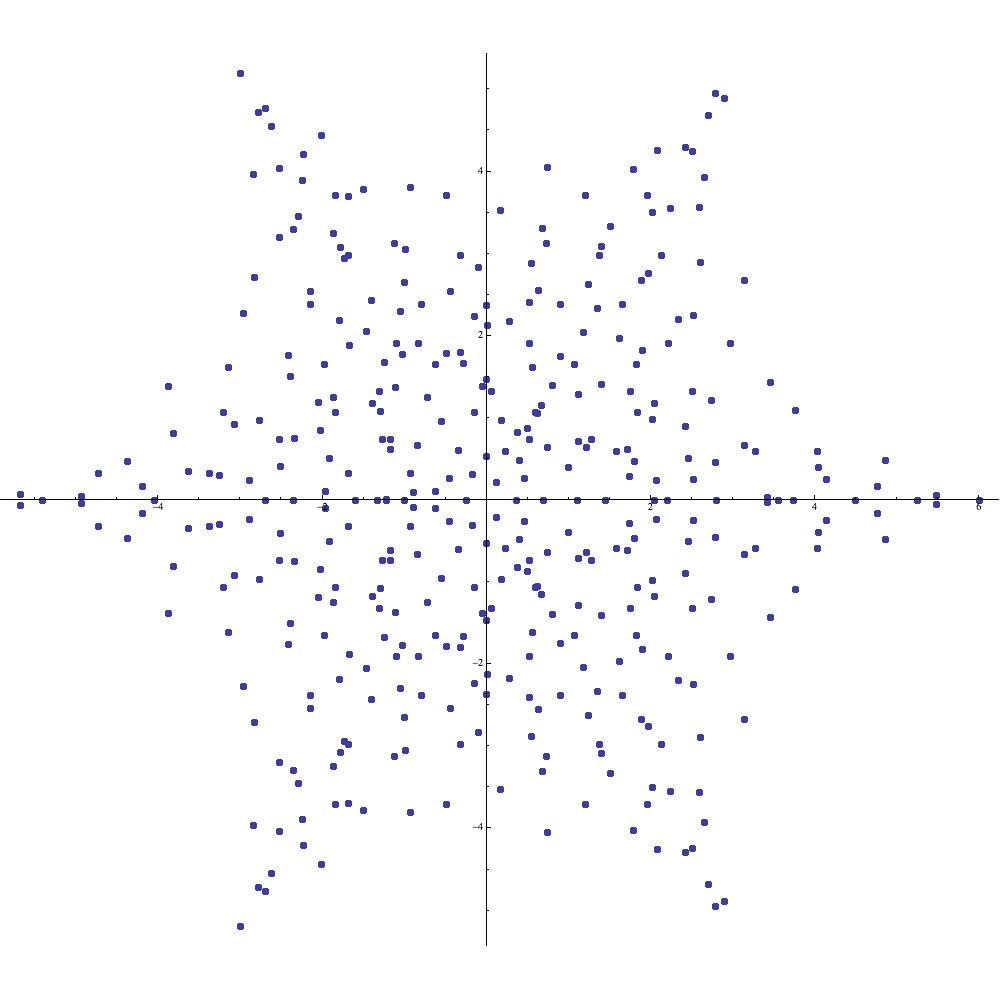
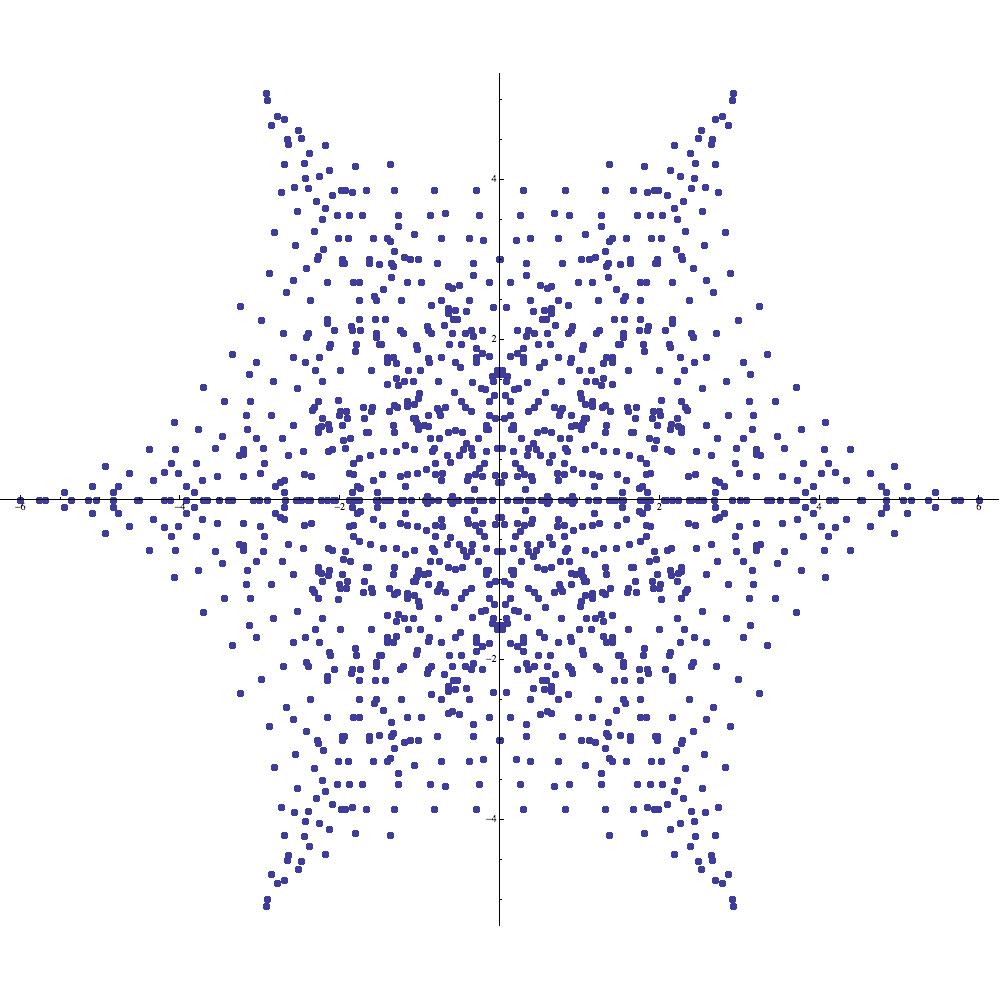
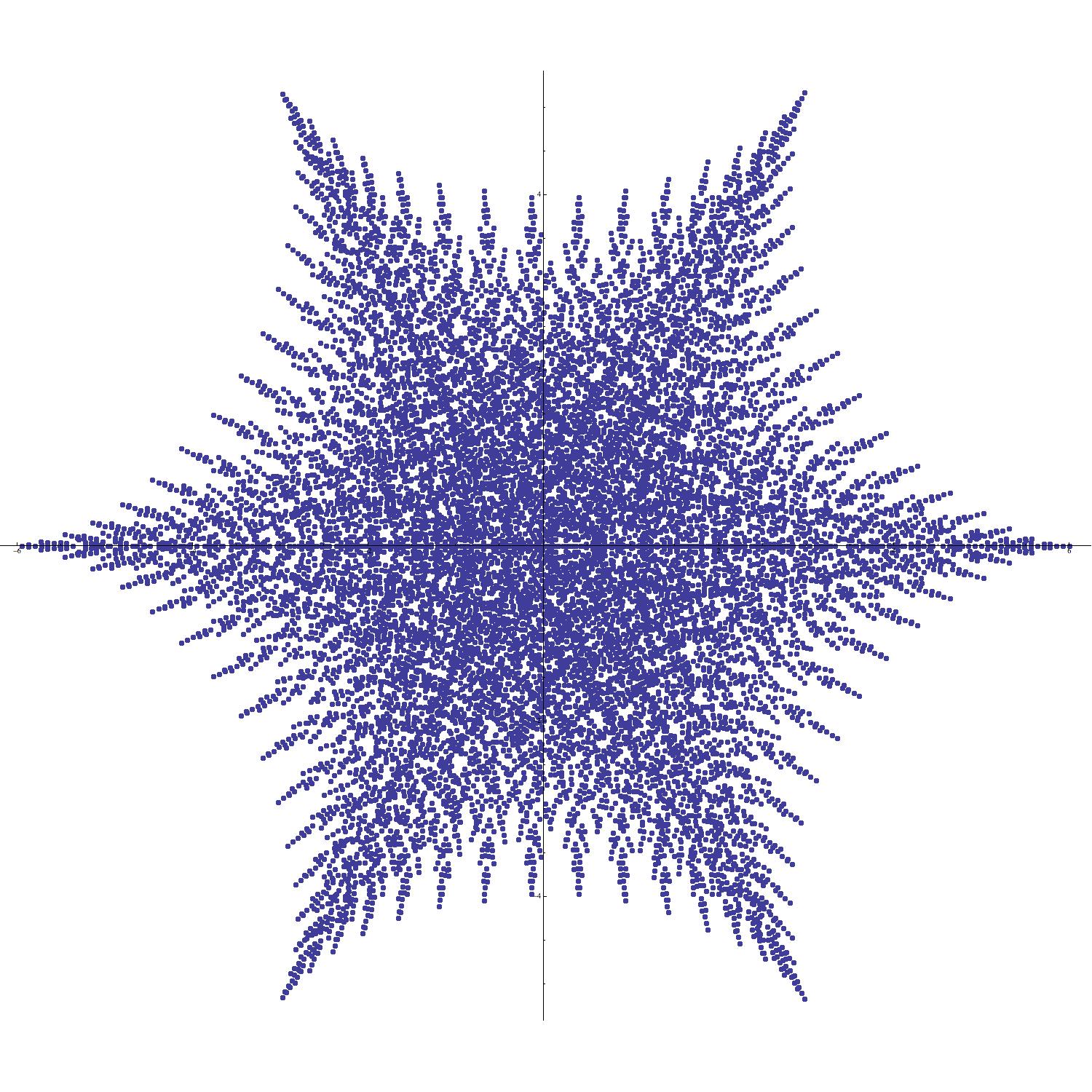
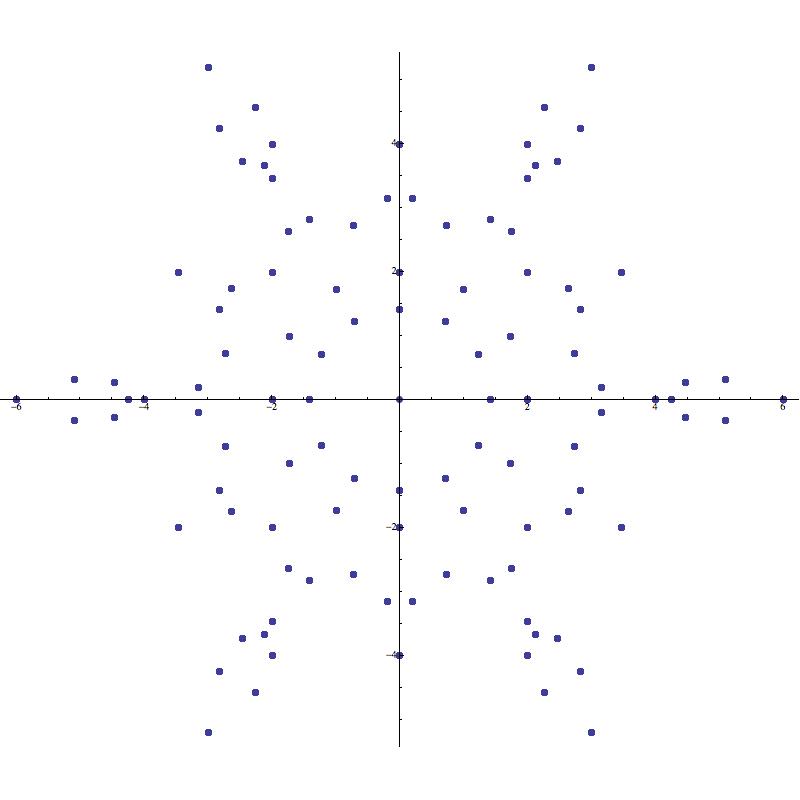
Before proceeding, we should remark that the fact that the range of the multivariate complex mapping (2.9) is indeed a filled hypocycloid is familiar to specialists in Lie theory and mathematical physics. Indeed, if belongs to , the Lie group consisting of all unitary matrices having determinant , then the eigenvalues of are of unit modulus and satisfy . In particular, this implies that
Therefore the range of the mapping (2.9) is precisely the set of all possible traces of matrices in (we thank G. Sarkis for calling this result to our attention). A similar treatment of several other classical Lie groups can be found in [12].
2.7. Fireballs
For the sake of reference, we recall the key identity (2.2) and write it here for convenient reference:
| (2.10) |
By starting with a known supercharacter whose image is of interest to us and then selecting the parameters and appropriately, we can often generate spectacular new supercharacter plots. This turns out to be a matter of some finesse and experimentation. Rather than attempt to formulate a general theorem, we prefer to present the main ideas through a series of instructive examples.
Example 2.
By Proposition 4, the image of the supercharacter is contained in the four-sided hypocycloid (sometimes referred to as an astroid) centered at the origin and having one of its cusps located at the point (see Figure 12(a)).



Using the identity (2.10) with the parameters , , , , and , we find that
Since the integer is arbitrary, it follows from the preceding computation that the image of is precisely the union of three rotated copies of our original image, yielding a “fireball” with cusps (see Figure 12(b)). Because the original image (Figure 12(a)) has no rotational symmetry, the resulting fireball image possesses only symmetry, despite the fact that a careless glance at the figure suggests the existence of symmetry. Along similar lines, setting and yields
so that the resulting “fireball” has cusps (see Figure 12(c)).
Example 3.






2.8. Asymptotic results
As suggested in the comments following Proposition 4 and illustrated in Figure 11, it is occasionally possible to predict the asymptotic behavior of specific families of supercharacter plots as the modulus tends to infinity (perhaps with some congruence restrictions imposed upon ). We develop here a general approach to determining the asymptotic appearance of certain families of symmetric supercharacter plots.
To begin with, fix and and let be a -orbit in . We next form the matrix whose columns are the vectors in . Suppose that can be row reduced over to obtain a simpler matrix . This is equivalent to asserting that where is a matrix over such that belongs to . Moreover, we also see that for . Since is invertible modulo , it follows from Cramer’s Rule that for any in the system has a solution . Putting this all together we find that
If the final rows of are zero (which happens, for instance, if ), then the preceding computations imply that the image of roughly approximates the image of the function defined by
| (2.11) |
Although there may be complications which arise depending upon the arithmetic relationships between the entries of and the modulus , in many cases the preceding recipe is sufficient to determine the asymptotic appearance of a family of supercharacter plots.
Example 4 (Hypocycloids revisited).
Suppose that and let denote the -orbit of the vector in . Following the preceding recipe note that
where is invertible over (here is obtained from the all ones matrix by first subtracting the identity matrix and then adding s to every entry of the th column). It follows that the image of is contained in the range of the function (2.9) encountered in our previous treatment of hypocycloids.
Example 5 (Hummingbirds).
Suppose that and let . In this case,
where is a unit in . It follows that as increases, the image of resembles the image of the function defined by
| (2.12) |
The result is a plot which, for sufficiently large , one might say, resembles a hummingbird in flight (see Figure 14).
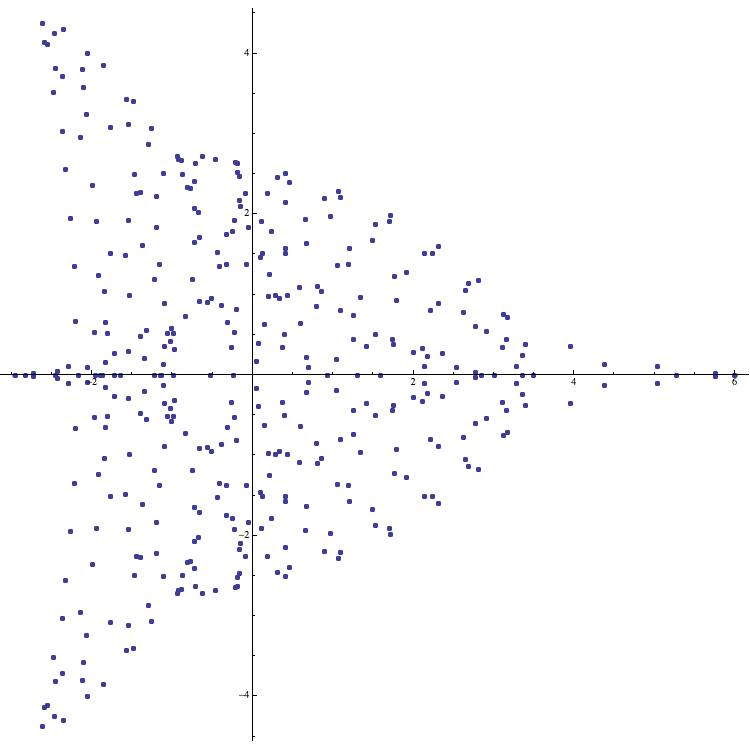
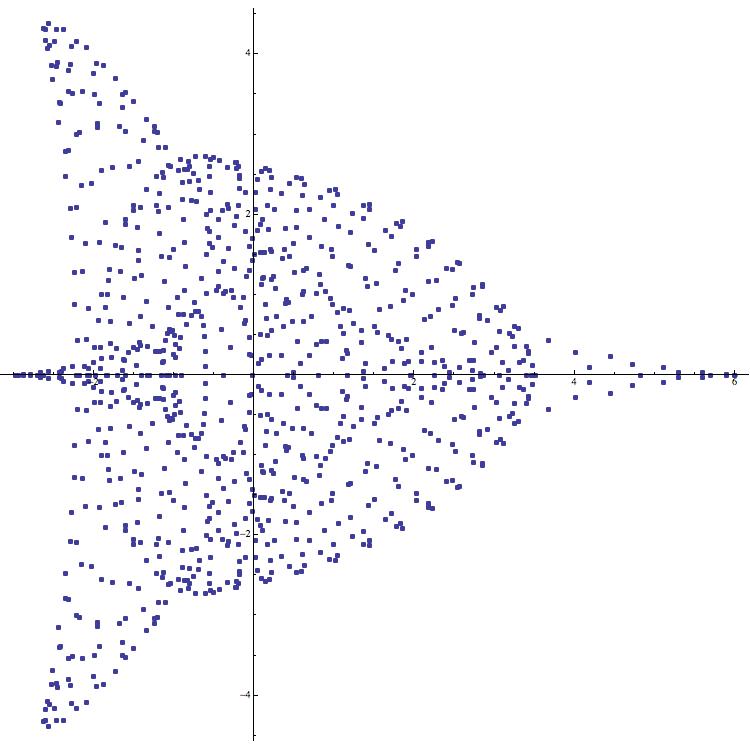

Example 6 (Manta rays).
Consider the symmetric supercharacter corresponding to . Working over we find that
where . Thus the image of is contained in the image of the function defined by
For large , the image of bears an uncanny resemblance to a manta ray followed by a trail of bubbles (see Figure 15).
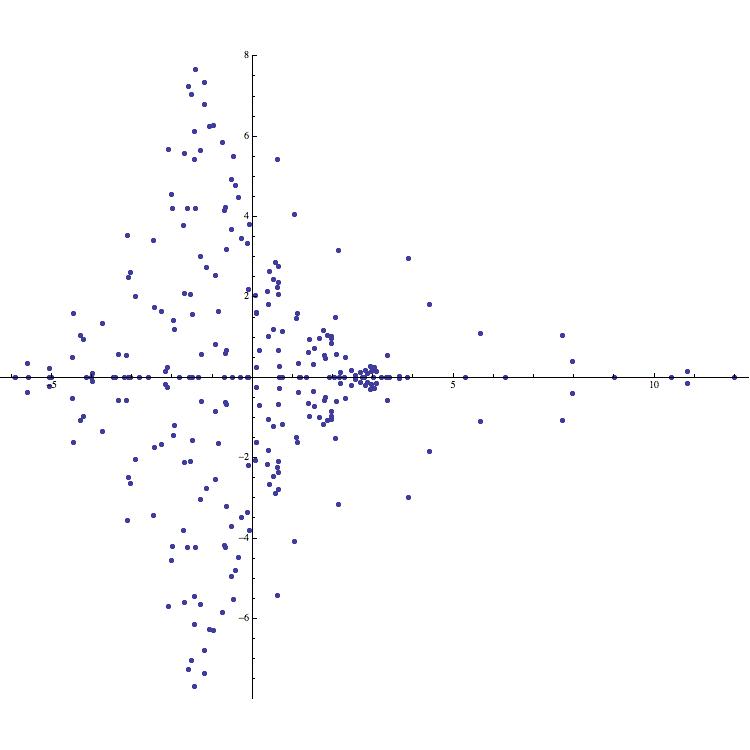
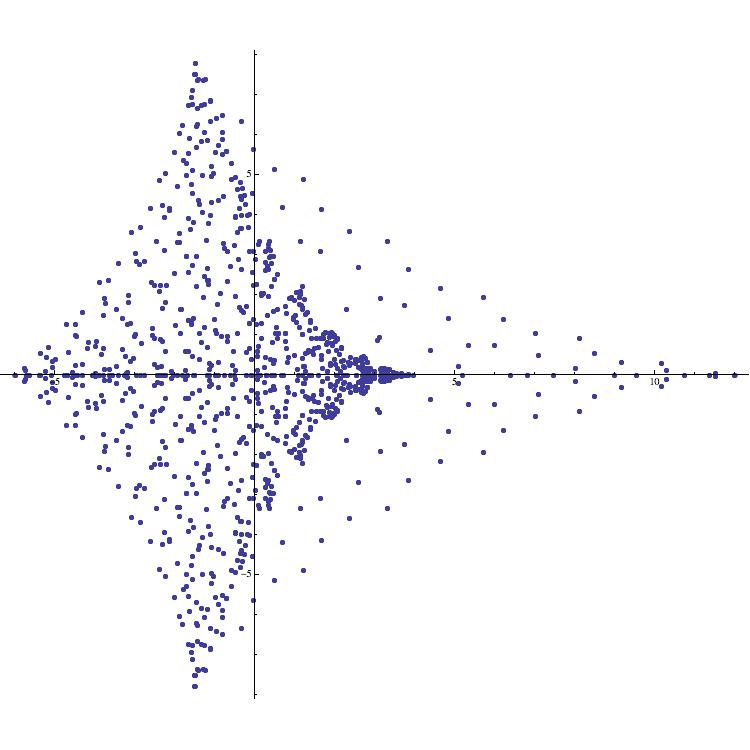

We conclude this note with a final example which combines a number of the ideas and techniques developed in the preceding pages.
Example 7 (Manta rays as graphical elements).
In light of Example 6, plotting the symmetric supercharacter corresponding to yields the familiar manta ray (see Figure 16(a)). Using (2.10) we are able to construct a number of intriguing new images based upon the initial manta ray image. Applying (2.10) with the parameters , , , and we find that
Roughly speaking, the image of is obtained by leaving half of the points in in place while negating the other half. This is precisely the behavior that is illustrated in Figure 16(b). In particular, the image in Figure 16(b) is not symmetric with respect to the imaginary axis. On the other hand, applying (2.10) with , , , and yields
whence the image of is precisely the union of three rotated copies of Figure 16(a) (see Figure 16(b)). Plots corresponding to various values of the parameter are provided in Figure 16. The reader is invited to experiment with (2.10) in order to explain the symmetries of these figures (e.g., Figure 16(e) gives the initial impression of having symmetry, whereas a closer inspection reveals that it only enjoys symmetry).
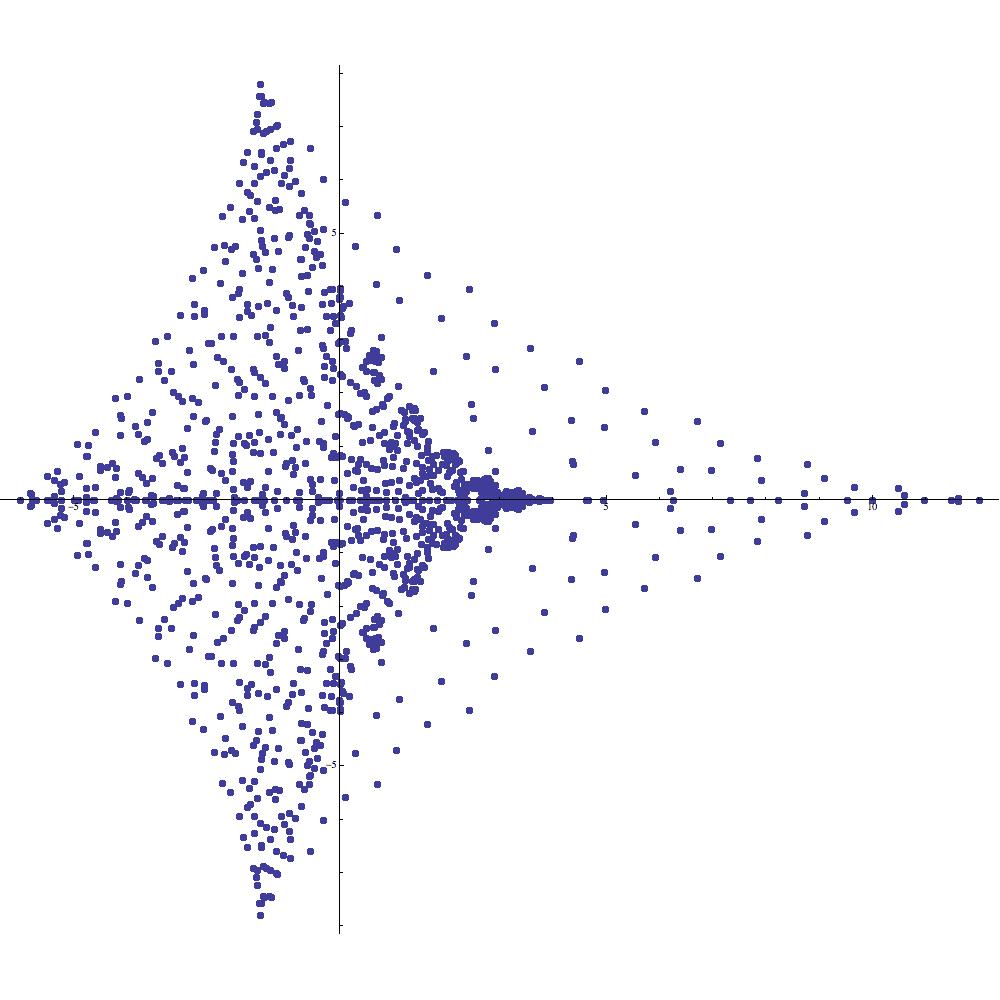
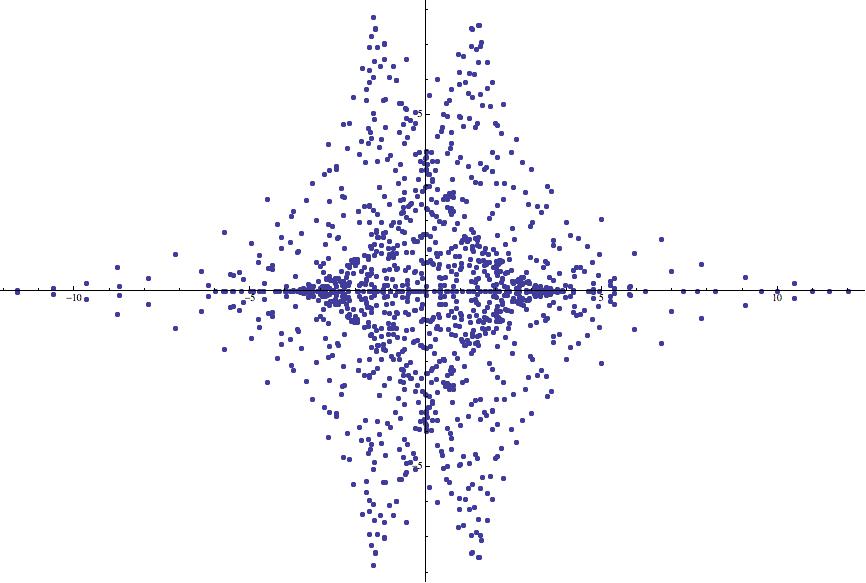
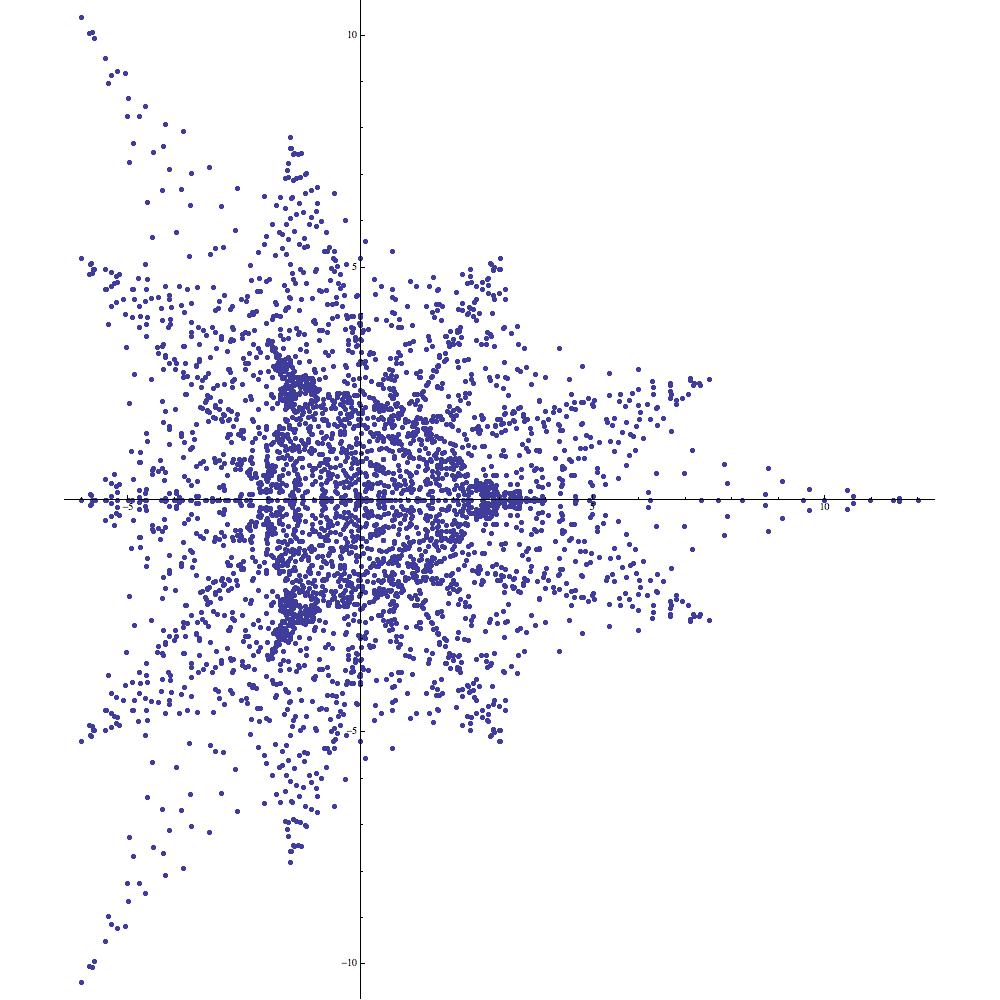

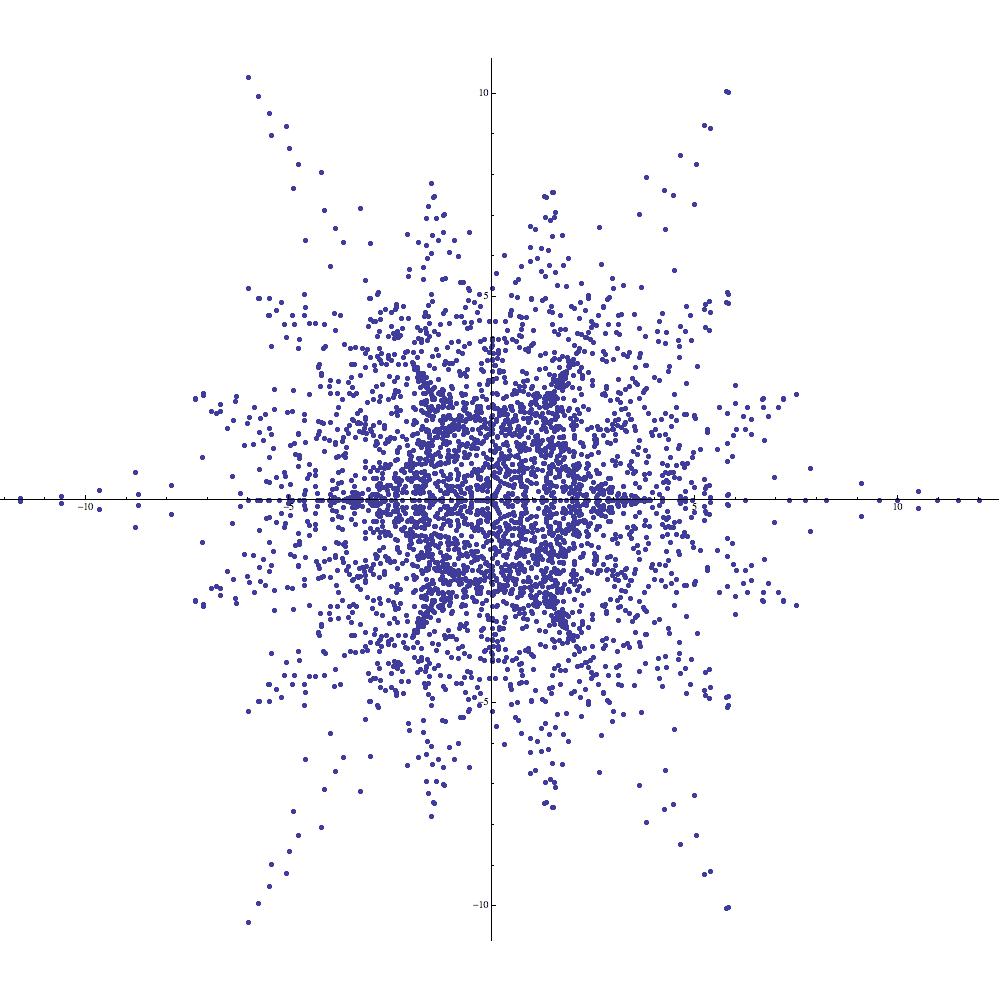
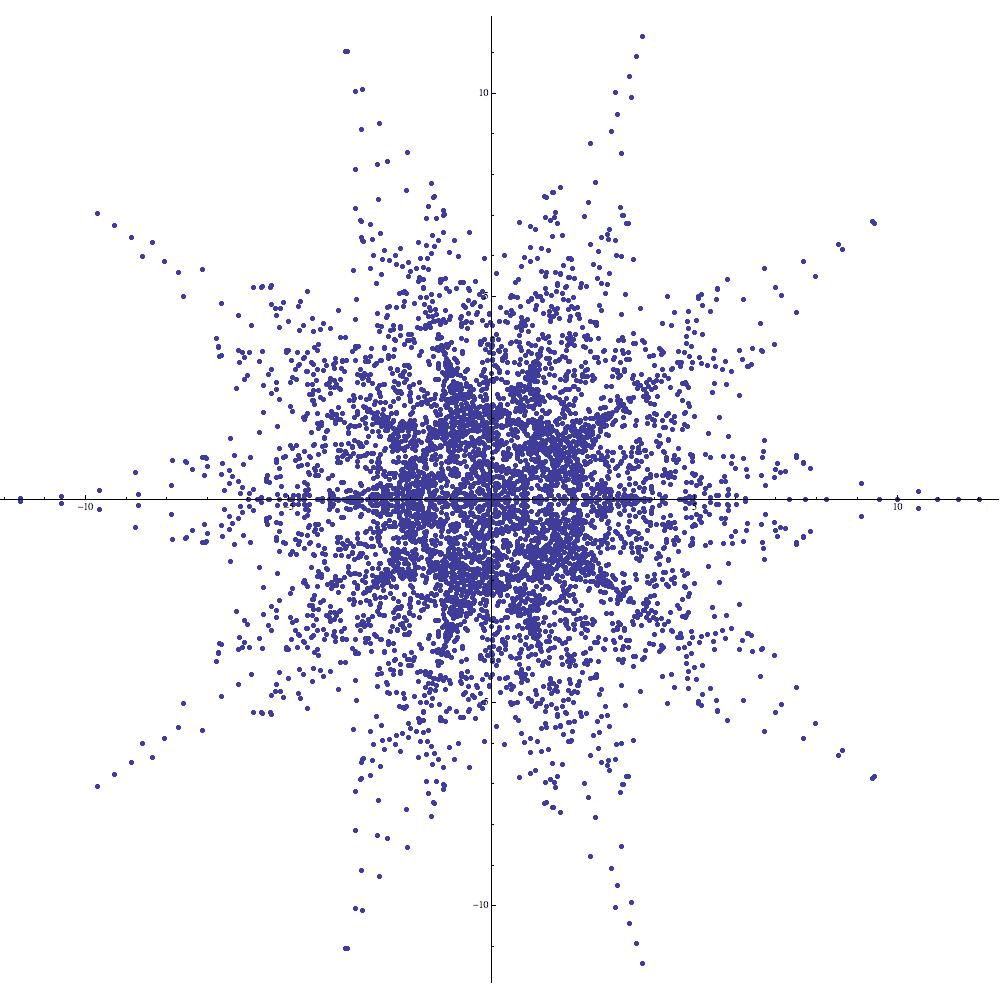
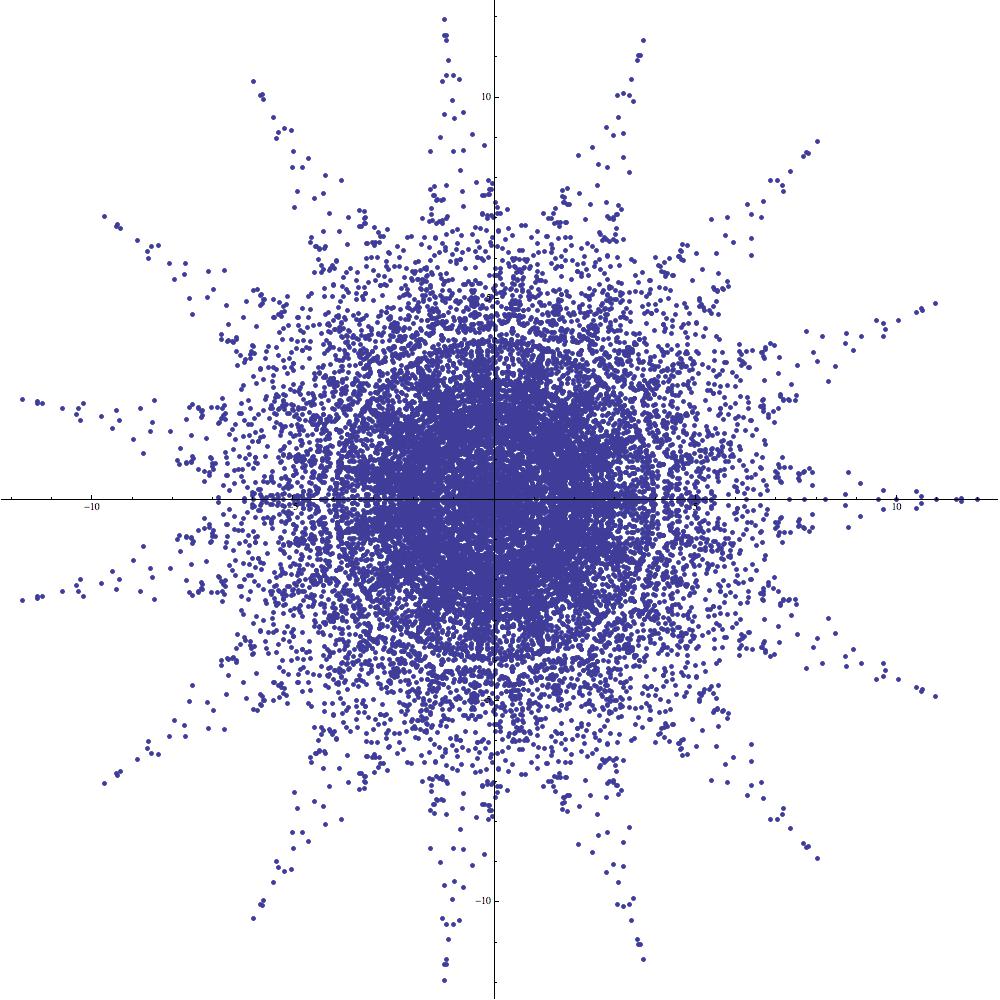
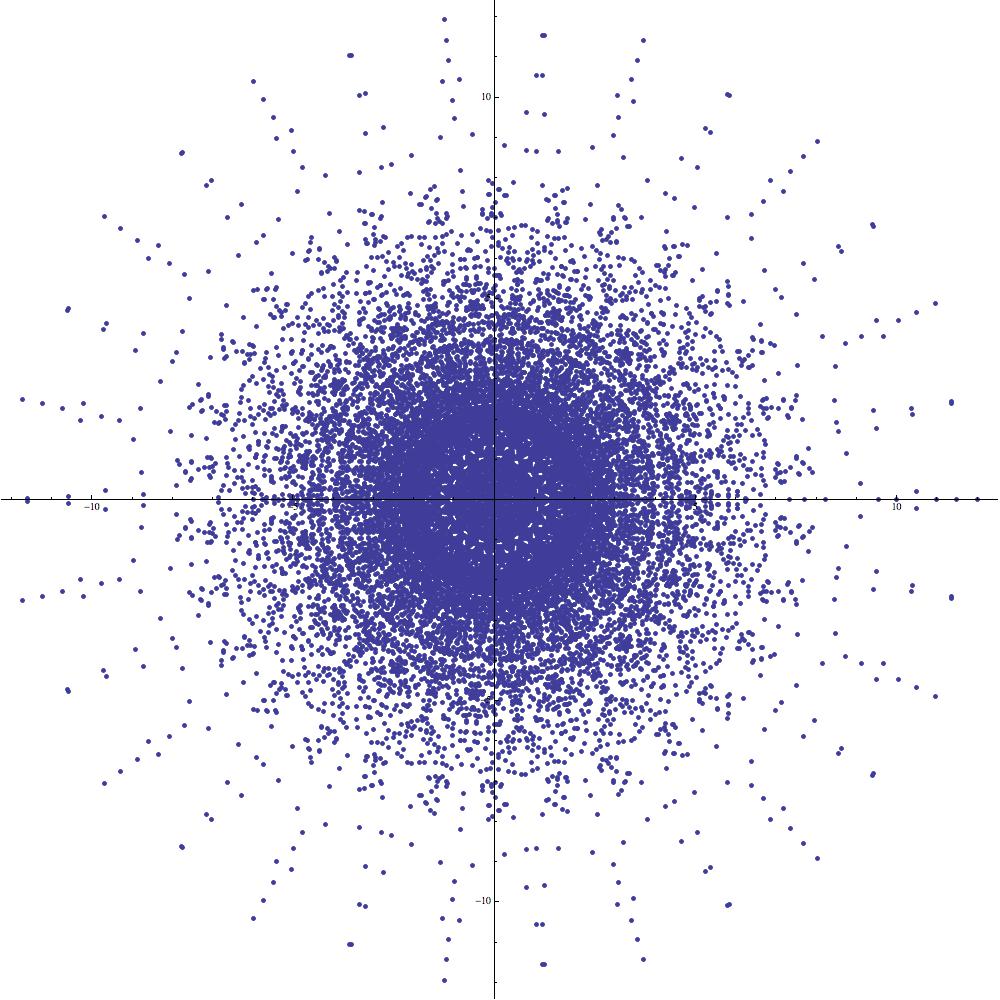
3. Open questions
As we have seen, symmetric supercharacters enjoy a vast and diverse array of striking visual features. We have surveyed many of these phenomena and provided explanations for quite a few of them. However, the discovery of these enigmatic plots and our subsequent investigations seem to generate more questions than answers. It is clear that our understanding of symmetric supercharacters is far from complete. Indeed, our work suggests that the deepest properties of these sums are yet to be discovered. In this spirit, we conclude this article with a number of open questions inspired by the preceding investigations.333In order to facilitate the work of other researchers, we have included in the following appendix the Mathematica code for generating supercharacter plots.
Question 1.
What happens if one considers the action of the alternating group on in place of ? How do the resulting images relate to the images obtained from ?
Question 2.
Recall from the introduction that the values of a symmetric supercharacter can be interpreted in terms of matrix permanents. Does this interpretation shed any light on the properties of symmetric supercharacters?
Question 3.
Question 4.
What is the mechanism which produces the nested pentagons in Figure 1(B)?
Question 5.
What is the mechanism which produces the jagged linear features appearing in Figure 2(A)?
Question 6.
What is the mechanism which produces the parabolic features appearing in Figure 2(C)?
Question 7.
Examples 4, 5, and 6 all concern certain families of symmetric supercharacters which exhibit clearly discernible asymptotic behavior as the modulus tends to infinity (perhaps with some congruence restrictions). Can one develop a general theory describing the asymptotic behavior of symmetric supercharacters?
Question 8.
Question 9.
Question 10.
Given the central role that the symmetric groups have played in this work, it is perhaps surprising that our approach has involved only a minimal level of combinatorial reasoning. What properties of symmetric supercharacters can be discovered using more sophisticated combinatorial tools?
Question 11.
Is there a relatively simple algebraic procedure which can be used to obtain the boundary of the image of a function of the form (2.11)? For instance, is there a simple description of the boundary of the “hummingbird” from Figure 14? Is there a simple description of the two regions suggested by the “manta ray” from Figure 15?
Question 12.
We have seen in Subsection 2.6 that the orbit yields an image which, for sufficiently large , closely approximates the set of all traces of matrices in . Can one identify other families of supercharacters whose asymptotic behavior is related to the traces of various subgroups of the unitary group ?
Appendix A Mathematica Code
We provide below the basic Mathematica code for producing plots of symmetric supercharacters.
superChar[n, char, class] numerically evaluates the supercharacter corresponding to the orbit of char (where is the length of
char) acting
on the superclass class;
e.g., superChar[7, {1,2,3,4}, {0,2,4,6}].
superChar[n_, char_, class_] := Module[{zeta, charOrbit, dotList},
zeta = N[Exp[2 Pi I /n]];
charOrbit = Permute[char, SymmetricGroup[Length[char]]];
dotList = class.# & /@ charOrbit;
Sum[zeta^dotList[[i]], {i, 1, Length[dotList]}]]
singleChar[n, char] gives a list of all values of the supercharacter corresponding to the orbit of char;
e.g., singleChar[7, {1,2,3,4}].
singleChar[n_, char_] := Module[{d, elems},
d = Length[char];
elems =
First /@
GroupOrbits[SymmetricGroup[d], Tuples[Range[0, n - 1], d],
Permute];
Chop[ParallelMap[superChar[n, char, #] &, elems]]]
singleCharVectorPlot[n, char] creates a vector graphics plot of a symmetric supercharacter;
e.g., singleCharVectorPlot[7, {1,2,3,4}].
singleCharVectorPlot[n_, char_] :=
ListPlot[{Re[#], Im[#]} & /@
DeleteDuplicates[Chop[singleChar[n, char]], Equal],
AspectRatio -> Automatic, PlotRange -> All]
singleCharBitmapPlot[n, char, range, unitRes] creates a bitmap image of a supercharacter,
with a range of [-range, range] along both axes and a unit resolution of unitRes;
e.g.,
singleCharBitmapPlot[7, {1,2,3,4}, 30, 30].
singleCharBitmapPlot[n_, char_, range_, unitRes_] :=
Module[{circ3, res, charRow, array, entries},
circ3 = {{0.3, 0.75, 0.3}, {0.75, 1, 0.75}, {0.3, 0.75, 0.3}};
res = unitRes*range;
charRow = singleChar[n, char];
array = Normal[SparseArray[{}, {2 res, 2 res}, 0]];
entries =
ParallelMap[
Round[({res - unitRes*Im[#], res + unitRes*Re[#]} &)@#] &,
charRow];
Do[With[{r = entries[[j, 1]], c = entries[[j, 2]]},
If[1 < r < 2 res && 1 < c < 2 res,
array[[r - 1 ;; r + 1, c - 1 ;; c + 1]] = circ3]],
{j, Length[charRow]}];
Image[1 - array]]
References
- [1] Carlos A. M. André. Basic characters of the unitriangular group. J. Algebra, 175(1):287–319, 1995.
- [2] Carlos A. M. André. The basic character table of the unitriangular group. J. Algebra, 241(1):437–471, 2001.
- [3] Carlos A. M. André. Basic characters of the unitriangular group (for arbitrary primes). Proc. Amer. Math. Soc., 130(7):1943–1954 (electronic), 2002.
- [4] Samuel G. Benidt, William R. S. Hall, and Anders O. F. Hendrickson. Upper and lower semimodularity of the supercharacter theory lattices of cyclic groups. Comm. Algebra. (to appear) http://arxiv.org/abs/1203.1638.
- [5] J.L. Brumbaugh, Madeleine Bulkow, Patrick S. Fleming, Luis Alberto Garcia, Stephan Ramon Garcia, Gizem Karaali, Matthew Michal, and Andrew P. Turner. Supercharacters, exponential sums, and the uncertainty principle. (preprint) http://arxiv.org/abs/1208.5271.
- [6] Persi Diaconis and I. M. Isaacs. Supercharacters and superclasses for algebra groups. Trans. Amer. Math. Soc., 360(5):2359–2392, 2008.
- [7] William Duke, Stephan Ramon Garcia, and Bob Lutz. The graphic nature of Gaussian periods. Proc. Amer. Math. Soc. (in press) http://arxiv.org/abs/1212.6825.
- [8] Patrick S. Fleming, Stephan Ramon Garcia, and Gizem Karaali. Classical Kloosterman sums: representation theory, magic squares, and Ramanujan multigraphs. J. Number Theory, 131(4):661–680, 2011.
- [9] Christopher Fowler, Stephan Ramon Garcia, and Gizem Karaali. Ramanujan sums as supercharacters. Ramanujan J. (in press) http://arxiv.org/abs/1201.1060.
- [10] Anders Olaf Flasch Hendrickson. Supercharacter theories of cyclic p-groups. ProQuest LLC, Ann Arbor, MI, 2008. Thesis (Ph.D.)–The University of Wisconsin - Madison.
- [11] I. Martin Isaacs. Character theory of finite groups. AMS Chelsea Publishing, Providence, RI, 2006. Corrected reprint of the 1976 original [Academic Press, New York; MR0460423].
- [12] N. Kaiser. Mean eigenvalues for simple, simply connected, compact Lie groups. J. Phys. A, 39(49):15287–15298, 2006.